air filter BUICK REGAL 1997 Owners Manual
[x] Cancel search | Manufacturer: BUICK, Model Year: 1997, Model line: REGAL, Model: BUICK REGAL 1997Pages: 422, PDF Size: 21.34 MB
Page 158 of 422
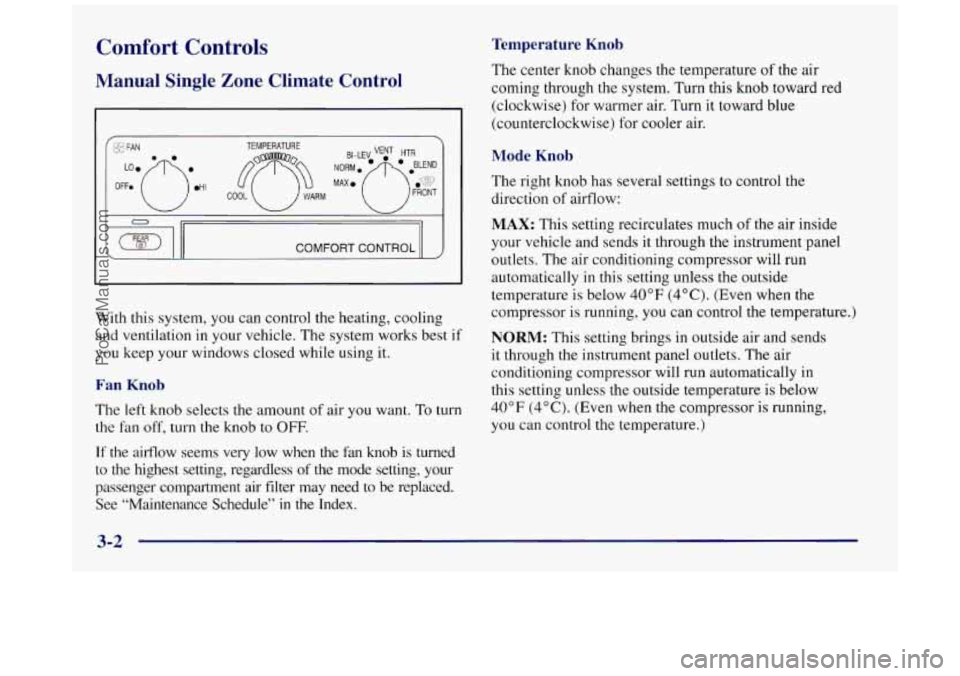
Comfort Controls
Manual Single Zone Climate Control
COMFORT CONTROL II
With this system, you can control the heating, cooling
and ventilation in your vehicle, The system works best if
you keep your windows closed while using it.
Fan Knob
The left knob selects the amount of air you want. To turn
the fan off, turn the knob to
OFF.
If the airflow seems very low when the fan knob is turned
to
the highest setting, regardless of the mode setting, your
passenger compartment air filter may need to be replaced. See “Maintenance Schedule”
in the Index.
Temperature Knob
The center knob changes the temperature of the air
coming through the system. Turn this knob toward red
(clockwise) for warmer air. Turn it toward blue
(counterclockwise) for cooler air.
Mode Knob
The right knob has several settings to control the
direction of airflow:
MAX: This setting recirculates much of the air inside
your vehicle and sends it through the instrument panel
outlets. The air conditioning compressor will run
automatically
in this setting unless the outside
temperature is below
40°F (4°C). (Even when the
compressor is running,
you can control the temperature.)
NORM: This setting brings in outside air and sends
it through the instrument panel outlets. The air
conditioning compressor will run automatically in
this setting unless the outside temperature
is below
40°F (4°C). (Even when the compressor is running,
you can control the temperature.)
3-2
ProCarManuals.com
Page 160 of 422
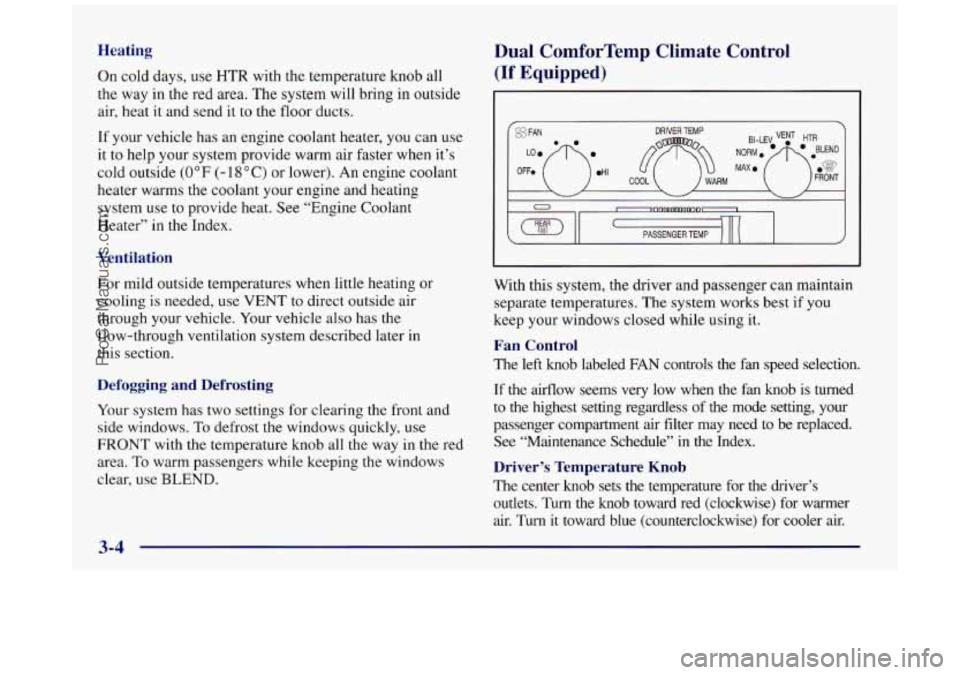
Heating
On cold days, use HTR with the temperature knob all
the way in the red area. The system will bring in outside
air, heat
it and send it to the floor ducts.
If your vehicle has an engine coolant heater, you can use
it to help your system provide warm air faster when it’s
cold outside
(0°F (- 18 O C) or lower). An engine coolant
heater warms the coolant your engine and heating
system use to provide heat. See “Engine Coolant
Heater” in the Index.
Ventilation
For mild outside temperatures when little heating or
cooling is needed, use VENT to direct outside air
through your vehicle. Your vehicle also has the
flow-through ventilation system described later in
this section.
Defogging and Defrosting
Your system has two settings for clearing the front and
side windows.
To defrost the windows quickly, use
FRONT with the temperature knob all the way in the red
area.
To warm passengers while keeping the windows
clear, use
BLEND.
Dual ComforTemp Climate Control
(If Equipped)
I_ .
With this system, the driver and passenger can maintain
separate temperatures. The system works best if you
keep your windows closed while using it.
Fan Control
The left knob labeled FAN controls the fan speed selection.
If the airflow seems very low when the fan knob is turned
to the highest setting regardless
of the mode setting, your
passenger compartment air filter may need to be replaced. See “Maintenance Schedule’’ in the Index.
Driver’s Temperature Knob
The center knob sets the temperature for the driver’s
outlets.
Turn the knob toward red (clockwise) for warmer
air. Turn it toward blue (counterclockwise) for cooler air.
3-4
ProCarManuals.com
Page 166 of 422
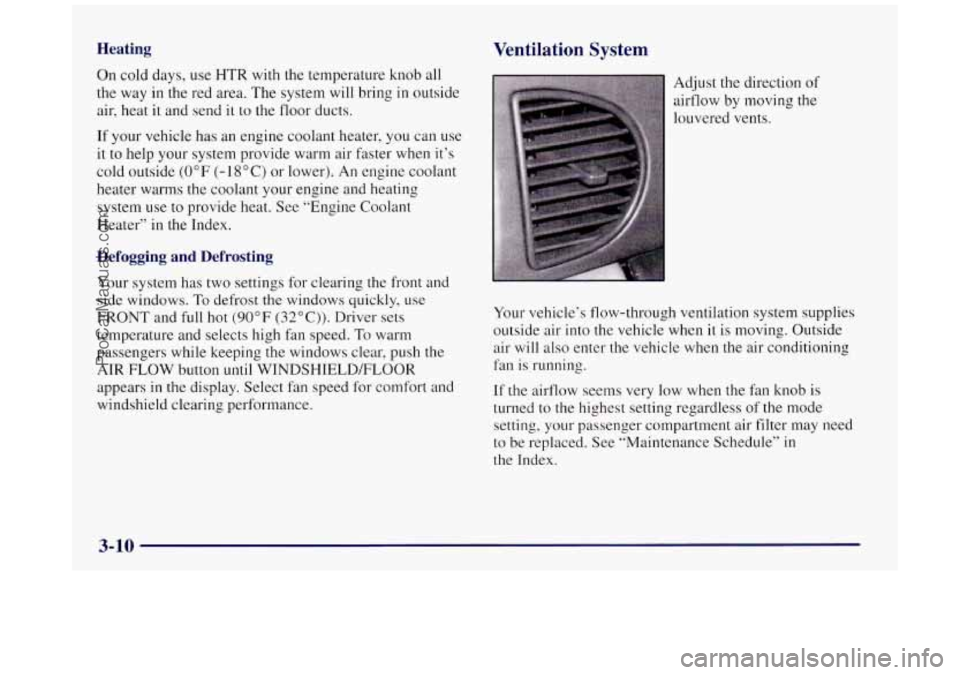
Heating
On cold days, use HTR with the temperature knob all
the way in the red area. The system will bring in outside
air, heat it and send it to the floor ducts.
Ventilation System
If your vehicle has an engine coolant heater, you can use
it to help your system provide warm air faster when it’s
cold outside
(0°F (-18°C) or lower). An engine coolant
heater warms the coolant your engine and heating
system use to provide heat. See “Engine Coolant
Heater” in
the Index.
Defogging and Defrosting
Your system has two settings for clearing the front and
side windows.
To defrost the windows quickly, use
FRONT and full hot
(90°F (32°C)). Driver sets
temperature and selects high fan speed.
To warm
passengers while keeping the windows clear, push the
AIR FLOW button until WINDSHTELDFLOOR
appears
in the display. Select fan speed for comfort and
windshield clearing performance. Adjust the direction
of
airflow by moving the
louvered vents.
Your vehicle’s flow-through ventilation system supplies
outside air into the vehicle when
it is moving. Outside
air will also enter the vehicle when the
air conditioning
fan is running.
If the airflow seems very low when the fan knob is
turned to the highest setting regardless of
the mode
setting, your passenger compartment air filter may need
to be replaced. See “Maintenance Schedule” in
the Index.
3-10
ProCarManuals.com
Page 292 of 422
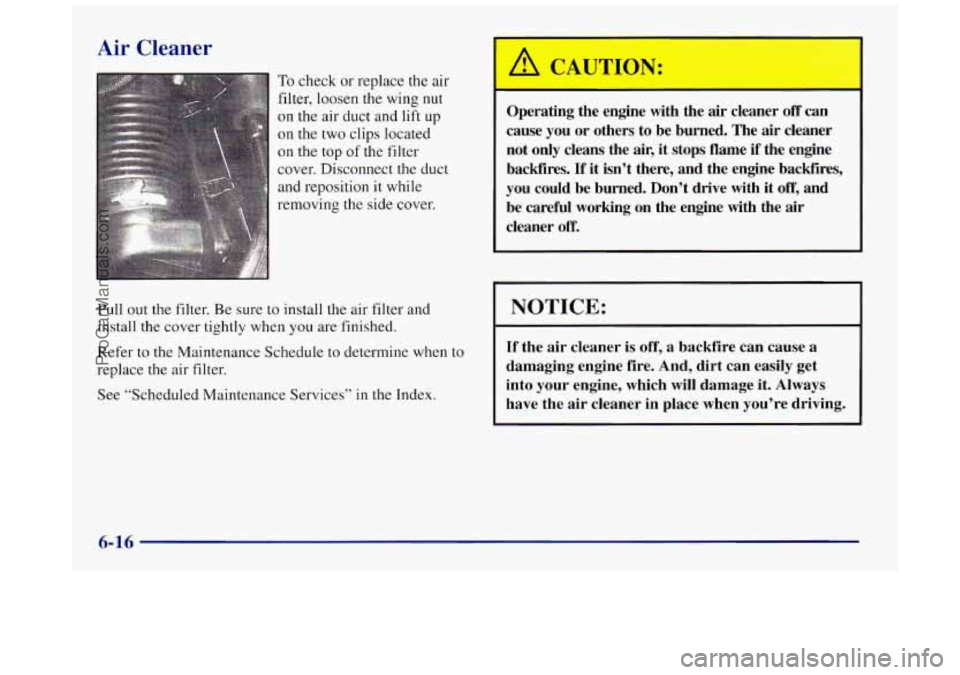
Air Cleaner
To check or replace the air
filter, loosen the wing nut
on the
air duct and lift up
on the
two clips located
on the top of the filter
cover, Disconnect the duct
and reposition it while
removing the side cover.
r
Operating the engine with the air cleaner off can
cause you or others to be burned. The air cleaner
not only cleans the air, it stops flame if the engine
backfires.
If it isn’t there, and the engine backfires,
you could be burned. Don’t drive with it
off, and
be careful working on the engine with the air
cleaner
off.
Pull out the filter. Be sure to install the air filter and NOTICE:
install the cover tightly when you are finished.
Refer to the Maintenance Schedule to determine when to
If the air cleaner is off, a backfire can cause a
replace the air filter. damaging engine fire. And, dirt can easily get
I
See “Scheduled Maintenance Services” in the Index.
I
into your engine, which will damage it. Always
have the air cleaner in place when you’re driving.
I
6-16
ProCarManuals.com
Page 293 of 422
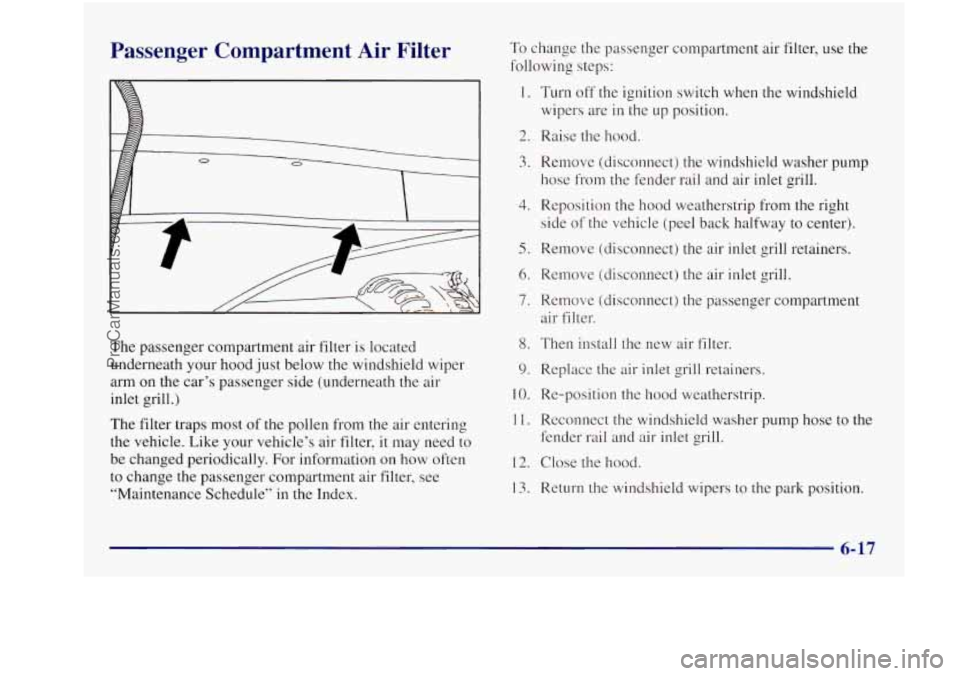
Passenger Compartment Air Filter
The passenger compartment air filter is located
underneath your hood just below the windshield wiper
arm on the car’s passenger side (underneath
the air
inlet grill.)
The filter traps most
of the pollen from the air entering
the vehicle. Like your vehicle’s air filter, it may need to
be changed periodically. For information on how often
to change the passenger compartment air
filter, see
“Maintenance Schedule”
in the Index.
To change the passenger compartment air filter, use the
following steps:
1.
2.
3.
4.
5.
6.
7.
8.
9.
10.
11.
12.
13.
Turn off the ignition switch when the windshield
wipers are
in the up position.
Raise the hood.
Remove (disconnect) the windshield washer pump
hose from the fender rail and air inlet grill.
Reposition the hood weatherstrip from the right
side of the vehicle (peel back halfway to center).
Remove (disconnect) the air inlet grill retainers.
Remove (disconnect) the air inlet grill.
Remove (disconnect) the passenger compartment
air filter.
Then install the new air filter.
Replace the air inlet grill retainers.
Re-position the hood weatherstrip.
Reconnect the windshield washer pump hose to the
fender rail and air inlet grill.
Close the hood.
Return the windshield wipers to the park position.
ProCarManuals.com
Page 339 of 422
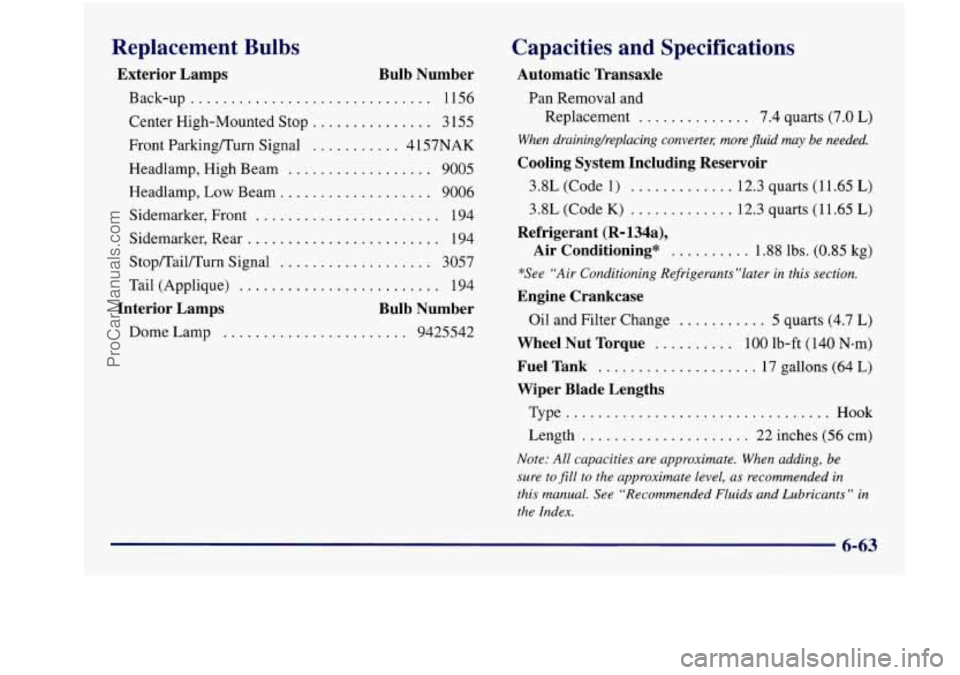
Replacement Bulbs
Exterior Lamps Bulb Number
Back-up .............................. 1156
Center High-Mounted Stop
............... 3 155
Front Parking/Turn Signal
........... 4 157NAK
Headlamp, High Beam
.................. 9005
Headlamp,
Low Beam. .................. 9006
Sidemarker, Front
....................... 194
Sidemarker, Rear
........................ 194
Stop/Tail/Turn Signal
................... 3057
Tail (Applique)
......................... 194
Interior Lamps Bulb Number
Dome Lamp ....................... 9425542
Capacities and Specifications
Automatic nansaxle
Pan Removal and
Replacement
.............. 7.4 quarts (7.0 L)
When drainingheplacing converter; more fluid my be needed.
Cooling System Including Reservoir
3.8L (Code 1) ............. 12.3 quarts (1 1.65 L)
3.8L (Code K) ............. 12.3 quarts (1 1.65 L)
Air Conditioning* .......... 1.88 lbs. (0.85 kg)
Refrigerant (R=134a),
*See “Air Conditioning Refrigerants”1ater in this section.
Engine Crankcase
Oil and Filter Change ........... 5 quarts (4.7 L)
Wheel Nut Torque .......... 100 lb-ft (140 N-m)
Fuel Tank .................... 17 gallons (64 L)
Wiper Blade Lengths
Type ................................. Hook
Length ..................... 22 inches (56 cm)
Note: All capacities are approximate. When adding, be
sure to
fill to the approximate level, as recommended in
this manual. See “Recommended Fluids and Lubricants
” in
the Index.
6-63
ProCarManuals.com
Page 341 of 422
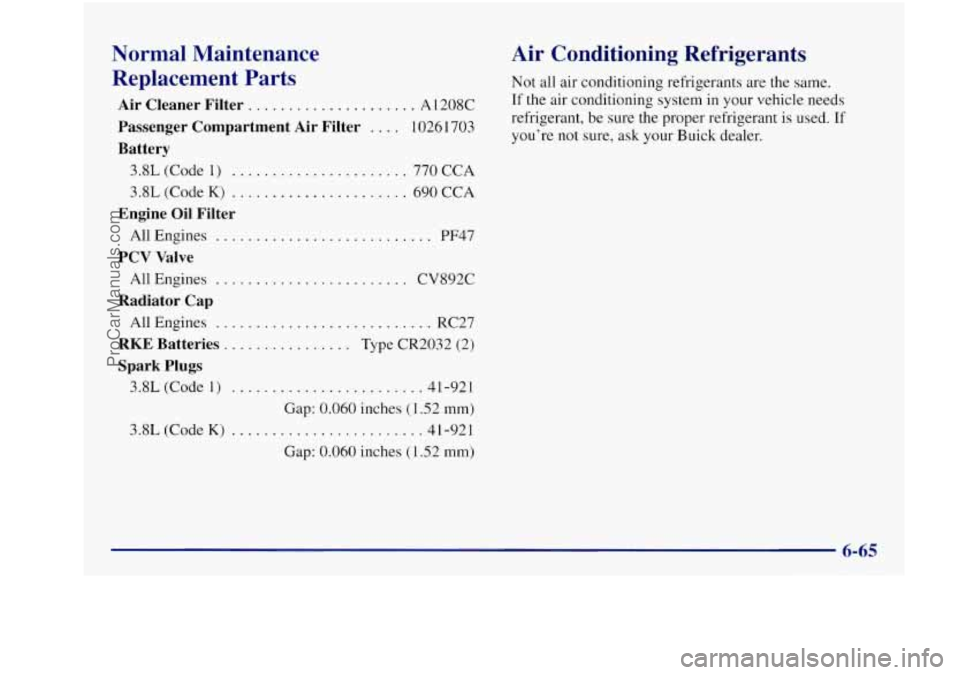
Normal Maintenance
Replacement Parts
Passenger Compartment Air Filter .... 10261 703
Air Cleaner Filter ..................... A 1208C
Battery
3.8L (Code 1) ...................... 770 CCA
3.8L (Code K) ...................... 690 CCA
Engine Oil Filter
All Engines ........................... PF47
PCV Valve
All Engines ........................ CV892C
Radiator Cap
All Engines ........................... RC27
RKE Batteries ................ Type CR2032 (2)
Spark Plugs
3.8L (Code 1) ........................ 41-921
Gap:
0.060 inches (1.52 mm)
3.8L (Code
K) ....................... .41-921
Gap: 0.060 inches (1.52
mm)
Air Conditioning Refrigerants
Not all air conditioning refrigerants are the same.
If the air conditioning system in your vehicle needs
refrigerant, be sure the proper refrigerant is used. If
you’re not sure, ask your Buick dealer.
ProCarManuals.com
Page 347 of 422
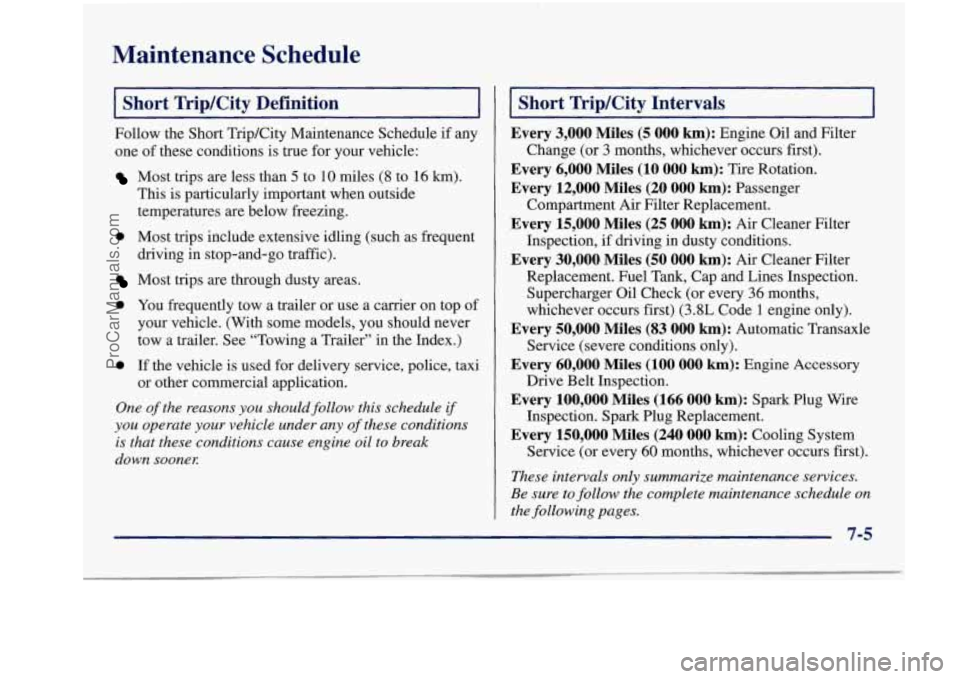
Maintenance Schedule
Short TripKity Definition
Follow the Short TripKity Maintenance Schedule if any
one of these conditions is true for your vehicle:
Most trips are less than 5 to 10 miles (8 to 16 km).
This is particularly important when outside
temperatures are below freezing.
0 Most trips include extensive idling (such as frequent
driving in stop-and-go traffic).
Most trips are through dusty areas.
0 You frequently tow a trailer or use a carrier on top of
your vehicle. (With some models, you should never
tow
a trailer. See “Towing a Trailer” in the Index.)
0 If the vehicle is used for delivery service, police, taxi
or other commercial application.
One
of the reasons you should follow this schedule if
you operate your vehicle under any of these conditions
is that these conditions cause engine oil to break
down soonel:
Short Trip/City Intervals
Every 3,000 Miles (5 000 km): Engine Oil and Filter
Change
(or 3 months, whichever occurs first).
Every 6,000 Miles (10 000 km): Tire Rotation.
Every 12,000 Miles (20 000 km): Passenger
Every 15,000 Miles (25 000 km): Air Cleaner Filter
Every 30,000 Miles (50 000 km): Air Cleaner Filter
Compartment Air Filter Replacement.
Inspection, if driving
in dusty conditions.
Replacement. Fuel Tank, Cap and Lines Inspection.
Supercharger Oil Check (or every 36 months,
whichever occurs first)
(3.8L Code 1 engine only).
Every 50,000 Miles (83 000 km): Automatic Transaxle
Service (severe conditions only).
Every 60,000 Miles (100 000 km): Engine Accessory
Drive Belt Inspection.
Every 100,000 Miles (166 000 km): Spark Plug Wire
Inspection. Spark Plug Replacement.
Every 150,000 Miles (240 000 km): Cooling System
Service (or every
60 months, whichever occurs first).
These intervals only summarize maintenance services.
Be sure to follow the complete maintenance schedule
on
the following pages.
I- 7-5
ProCarManuals.com
Page 348 of 422
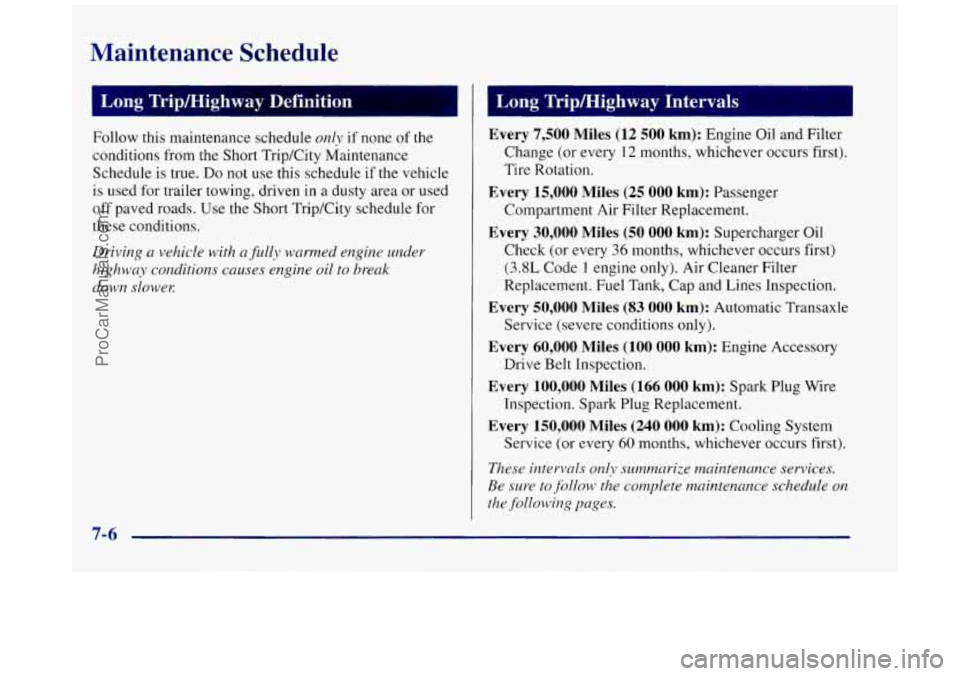
Maintenance Schedule
Follow this maintenance schedule only if none of the
conditions from
the Short TripKity Maintenance
Schedule is true.
Do not use this schedule if the vehicle
is used for trailer towing, driven in a dusty area or used
off paved roads. Use the Short Trip/City schedule for
these conditions.
Driving a vehicle with a fidly warmed engine under
highway conditions causes engine oil to break
down
slowex
Every 7,500 Miles (12 500 km): Engine Oil and Filter
Change (or every 12 months, whichever occurs first).
Tire Rotation.
Every 15,000 Miles (25 000 km): Passenger
Compartment Air Filter Replacement.
Every 30,000 Miles (50 000 km): Supercharger Oil
Check (or every
36 months, whichever occurs first)
(3.8L Code 1 engine only). Air Cleaner Filter
Replacement. Fuel Tank, Cap and Lines Inspection.
Every 50,000 Miles (83 000 km): Automatic Transaxle
Service (severe conditions only).
Every 60,000 Miles (100 000 km): Engine Accessory
Drive Belt Inspection.
Every 100,000 Miles (166 000 krn): Spark Plug Wire
Inspection. Spark Plug Replacement.
Every 150,000 Miles (240 000 km): Cooling System
Service (or every
60 months, whichever occurs first).
These intervals only summarize maintenance services.
Be sure to follow the complete nzaintenance schedule on
the following pages.
7-6
ProCarManuals.com
Page 351 of 422
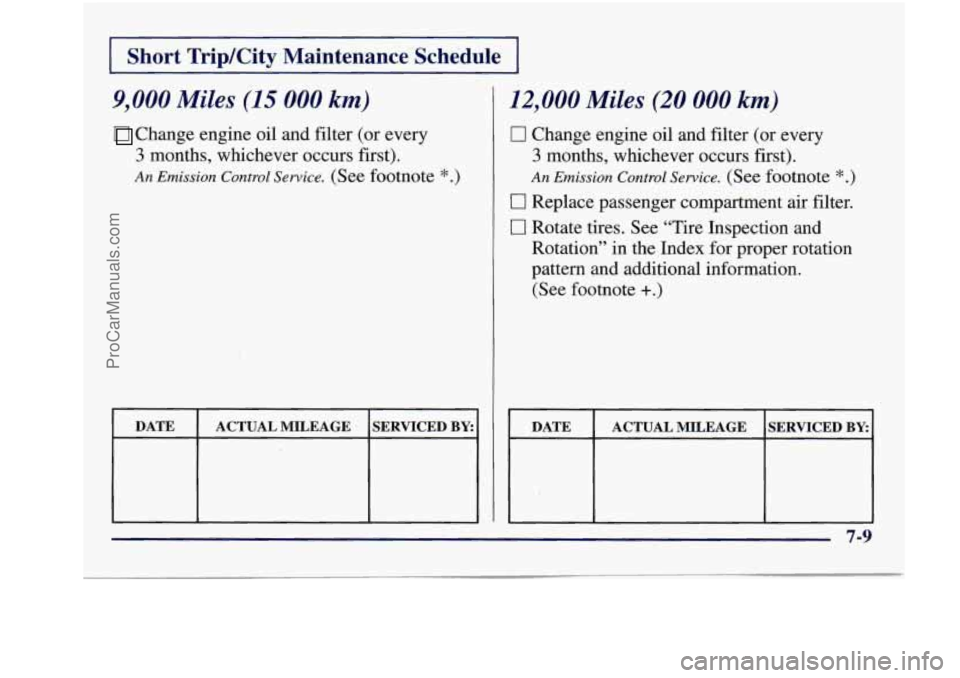
I Short Trip/City Maintenance Schedule I
9,000 Miles (15 000 km)
Change engine oil and filter (or every
3 months, whichever occurs first).
An Emission Control Service. (See footnote * .)
DATE
SERVICED BY: ACTUAL MILEAGE
12,000 Miles (20 000 km)
0 Change engine oil and filter (or every
3 months, whichever occurs first).
An Emission Control Service. (See footnote *.)
0 Replace passenger compartment air filter.
0 Rotate tires. See “Tire Inspection and
Rotation” in the Index for proper rotation
pattern and additional information.
(See footnote
+.)
DATE SERVICED BY: ACTUAL MILEAGE
7-9
ProCarManuals.com